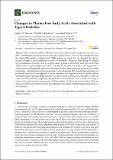Files in this item
Changes in plasma free fatty acids associated with type-2 diabetes
Item metadata
| dc.contributor.author | Sobczak, Amélie I. S. | |
| dc.contributor.author | Blindauer, Claudia A. | |
| dc.contributor.author | Stewart, Alan J. | |
| dc.date.accessioned | 2019-08-28T13:30:02Z | |
| dc.date.available | 2019-08-28T13:30:02Z | |
| dc.date.issued | 2019-08-28 | |
| dc.identifier.citation | Sobczak , A I S , Blindauer , C A & Stewart , A J 2019 , ' Changes in plasma free fatty acids associated with type-2 diabetes ' , Nutrients , vol. 11 , no. 9 , 2022 . https://doi.org/10.3390/nu11092022 | en |
| dc.identifier.issn | 2072-6643 | |
| dc.identifier.other | PURE: 260828968 | |
| dc.identifier.other | PURE UUID: d223cb72-41e9-49cf-ab53-32800129291e | |
| dc.identifier.other | Scopus: 85071736222 | |
| dc.identifier.other | WOS: 000487964600116 | |
| dc.identifier.uri | https://hdl.handle.net/10023/18387 | |
| dc.description | This research was funded by the British Heart Foundation, grant numbers PG/15/9/31270 and FS/15/42/3155 and by the Leverhulme Trust, grant number RPG-2017-214. | en |
| dc.description.abstract | Type 2 diabetes mellitus (T2DM) is associated with increased total plasma free fatty acid (FFA) concentrations and an elevated risk of cardiovascular disease. The exact mechanisms by which the plasma FFA profile of subjects with T2DM changes is unclear, but it is thought that dietary fats and changes to lipid metabolism are likely to contribute. Therefore, establishing the changes in concentrations of specific FFAs in an individual’s plasma is important. Each type of FFA has different effects on physiological processes, including the regulation of lipolysis and lipogenesis in adipose tissue, inflammation, endocrine signalling and the composition and properties of cellular membranes. Alterations in such processes due to altered plasma FFA concentrations/profiles can potentially result in the development of insulin resistance and coagulatory defects. Finally, fibrates and statins, lipid-regulating drugs prescribed to subjects with T2DM, are also thought to exert part of their beneficial effects by impacting on plasma FFA concentrations. Thus, it is also interesting to consider their effects on the concentration of FFAs in plasma. Collectively, we review how FFAs are altered in T2DM and explore the likely downstream physiological and pathological implications of such changes. | |
| dc.format.extent | 42 | |
| dc.language.iso | eng | |
| dc.relation.ispartof | Nutrients | en |
| dc.rights | Copyright © 2019 by the authors. Licensee MDPI, Basel, Switzerland. This article is an open access article distributed under the terms and conditions of the Creative Commons Attribution (CC BY) license (http://creativecommons.org/licenses/by/4.0/). | en |
| dc.subject | Cardiovascular disease | en |
| dc.subject | Fibrates | en |
| dc.subject | Free fatty acids | en |
| dc.subject | Lipidomics | en |
| dc.subject | Metabolism | en |
| dc.subject | Statins | en |
| dc.subject | Type-2 diabetes mellitus | en |
| dc.subject | RA0421 Public health. Hygiene. Preventive Medicine | en |
| dc.subject | SDG 3 - Good Health and Well-being | en |
| dc.subject.lcc | RA0421 | en |
| dc.title | Changes in plasma free fatty acids associated with type-2 diabetes | en |
| dc.type | Journal item | en |
| dc.contributor.sponsor | The Leverhulme Trust | en |
| dc.contributor.sponsor | British Heart Foundation | en |
| dc.contributor.sponsor | British Heart Foundation | en |
| dc.description.version | Publisher PDF | en |
| dc.contributor.institution | University of St Andrews. Sir James Mackenzie Institute for Early Diagnosis | en |
| dc.contributor.institution | University of St Andrews. Cellular Medicine Division | en |
| dc.contributor.institution | University of St Andrews. Biomedical Sciences Research Complex | en |
| dc.contributor.institution | University of St Andrews. Institute of Behavioural and Neural Sciences | en |
| dc.contributor.institution | University of St Andrews. School of Medicine | en |
| dc.identifier.doi | https://doi.org/10.3390/nu11092022 | |
| dc.description.status | Peer reviewed | en |
| dc.identifier.url | https://www.mdpi.com/2072-6643/11/9/2022 | en |
| dc.identifier.grantnumber | RPG-2017-214 | en |
| dc.identifier.grantnumber | FS/15/42/31556 | en |
| dc.identifier.grantnumber | PG/15/9/31270 | en |
This item appears in the following Collection(s)
Items in the St Andrews Research Repository are protected by copyright, with all rights reserved, unless otherwise indicated.

